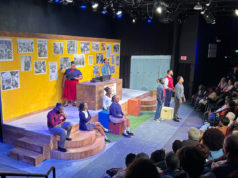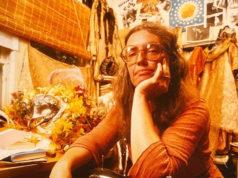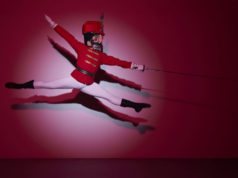For lovers of story ballets, there’s none more entertaining than Don Quixote, at least the version created by Texas Ballet Theater director Ben Stevenson, which had its North Texas premiere last weekend in Bass Performance Hall. Stylish choreography, high-energy dancing, sumptuous sets and costumes –– everything you’d want in a big classical ballet was there (except live music; the company can’t afford an orchestra these days).
 As the young lovers Kitri and Basilio, Leticia Oliveira and Eddy Tovar added zing to their high-voltage performances on opening night that also included some Bolshoi-style running leaps, she landing on her side in his arms, parallel to the floor, without a tremor showing in his body from the impact. And Oliveira’s 32 fouettes in the final duet were a joyous free-for-all: double and triple turns thrown in willy-nilly with hands on hips or arms extended straight out, at times fanning herself coquettishly as she peeped out at the audience. The role was made for her explosive personality. Tovar did wonderful turns with one leg extended 90 degrees and a series of great leaps around the stage. His dancing and dramatic scope have expanded in his years with the company, and he made a dashing young suitor. Together they created a fresh and exciting duo that earned a roar of approval.
As the young lovers Kitri and Basilio, Leticia Oliveira and Eddy Tovar added zing to their high-voltage performances on opening night that also included some Bolshoi-style running leaps, she landing on her side in his arms, parallel to the floor, without a tremor showing in his body from the impact. And Oliveira’s 32 fouettes in the final duet were a joyous free-for-all: double and triple turns thrown in willy-nilly with hands on hips or arms extended straight out, at times fanning herself coquettishly as she peeped out at the audience. The role was made for her explosive personality. Tovar did wonderful turns with one leg extended 90 degrees and a series of great leaps around the stage. His dancing and dramatic scope have expanded in his years with the company, and he made a dashing young suitor. Together they created a fresh and exciting duo that earned a roar of approval.
Lucas Priolo, one of the company’s leading dancers, has performed many fairy tale princes and heroes for the company. (He danced Basilio at the matinee performances.) Interestingly, perhaps his most memorable role yet is a non-dancing one. He was dead on as Don Quixote. It’s easy for a young man to capture the comic foibles of an old one. Not so easy is preserving some nobility in a well-intentioned but weathered soldier lost in illusion who wanders the world to a different drumbeat. Priolo did it with sensitive insight that made you really care about the deluded old knight.
The Don entered the first act on horseback; fortunately, a docile, well-mannered palomino that didn’t mess the stage or bolt in fright at the raucous fanfare that accompanied the arrival. (What might have happened with live brass instruments blaring from the orchestra pit under the creature’s nose is something else again.) The Don meets the lovely Kitri and immediately confuses her with his beloved Dulcinea from years past. After rescuing his servant Sancho Panza (Li Anlin) from villagers who are tossing him in the air for stealing a chicken, the Don runs into Kitri again in a gypsy camp. A nearby windmill begins turning, which he perceives as a threatening monster. Charging it with a lance, he gets knocked senseless for his trouble.
Energetically danced by Simon Wexler, Cupid (or “Amor Man” as he is listed in the playbill) pierces Don Quixote with an arrow, and the years fall away from the old man’s mind. He begins dancing a courtly minuet with his beautiful Dulcinea (also danced by Oliveira) accompanied by a corps of 12 ballerinas. For this, the ballet’s only sequence of straight-line classical choreography, they performed with the precision of a drill team.
Basilio tricks his prospective father-in-law into consenting to his marrying Kitri by pretending to kill himself, asking this last favor before dying. The father consents, Basilio miraculously recovers, the Don realizes that Kitri is really not his Dulcinea, and everyone comes away happy.
A number of exuberant ensembles dotted the ballet’s landscape, passionately performing Spanish- and gypsy-inspired dances. The dancing throughout was the most intense and totally involved I recall from the company. In fact the whole show was the strongest TBT has presented in years. Add a live orchestra, and you couldn’t ask for anything more.
Bruce Wood Dance Project
Bruce Wood Dance Company, the popular modern group, closed its Fort Worth doors four years ago in financial disarray. But the company recently opened them again, this time as the Bruce Wood Dance Project and in Dallas, at the classy new Montgomery Arts Theater, part of the Booker T. Washington High School for the Performing and Visual Arts next door to the Winspear Opera House. The Montgomery seats 450 and has an oversized stage, one with a 50-foot wide proscenium, only eight feet smaller than the one at Bass Performance Hall, the company’s previous venue.
Last weekend’s debut at the Montgomery presented several works, including two new pieces: a charmer called Happy Feet for the whole company and a romantic interlude for two couples, Our Last Lost Chance. Based on the free-flowing performances and polished interpretations of Wood’s vast dance vocabulary, you’d never know the company had been on hiatus for so long.
Happy Feet explored an endless range of quirky movements that brought chuckles and laughs from the audience. The dancers moved back and forth across the stage in blissful surrender to the unusual choreography. They were accompanied by a quartet that included Fort Worth vocalist and accordionist Ginny Mac, guitarist Glenn McLaughlin, violinist Carlo Canlas, and bassist Bach Norwood, churning out honkytonk arrangements of several songs.
Our Last Lost Chance was an introspective look at two couples’ intertwined relationships, performed on a darkened stage with the dancers in white. Minimalist music overlaid with what sounded like deafening trains and sweeping winds formed a tonal backdrop.
The piece was followed by an angst-ridden solo danced by Nycole Ray called The Edge of My Life so Far (2010). She took out her frustrations by pounding a table covered in white powder –– the stuff rose in clouds round her, the mood underlined by the recorded minimalist music of Michael Nyman.
A revival of Woods’ enigmatic Bolero, set to the Ravel score, brought things to a stirring close. The setting suggested a train station; crowd noises and track announcements were broadcast over the recorded music. But the women in slinky black dresses and the men in matching white shirts and vests with black trousers looked like employees of an upscale night spot getting ready to open up. As the music intensified, their movements become more agitated, and they ended up throwing one another across the stage in a frenzy. Whatever they were, the effect was electric, and the audience was left gasping.
Future plans are still nebulous, but the reception here was so positive that a new season of some kind seems likely. One can only hope that BWDP has found a permanent base. With this kind of dancing, it deserves a place in the sun.











